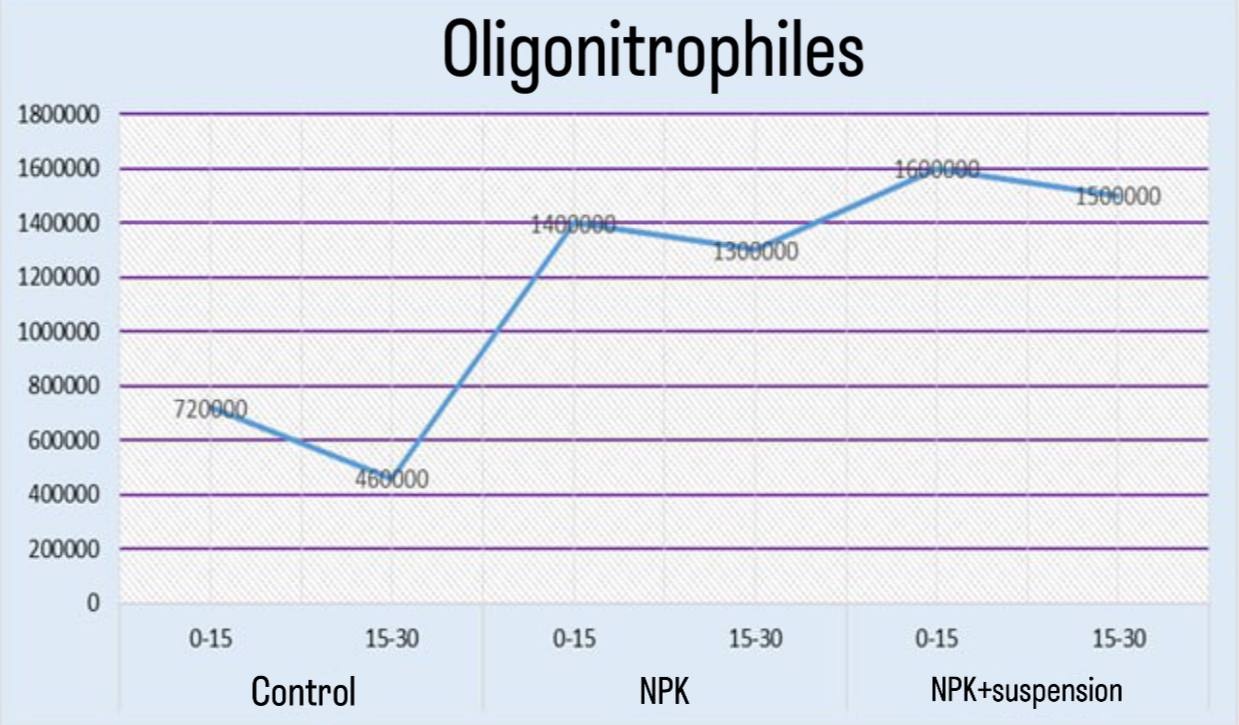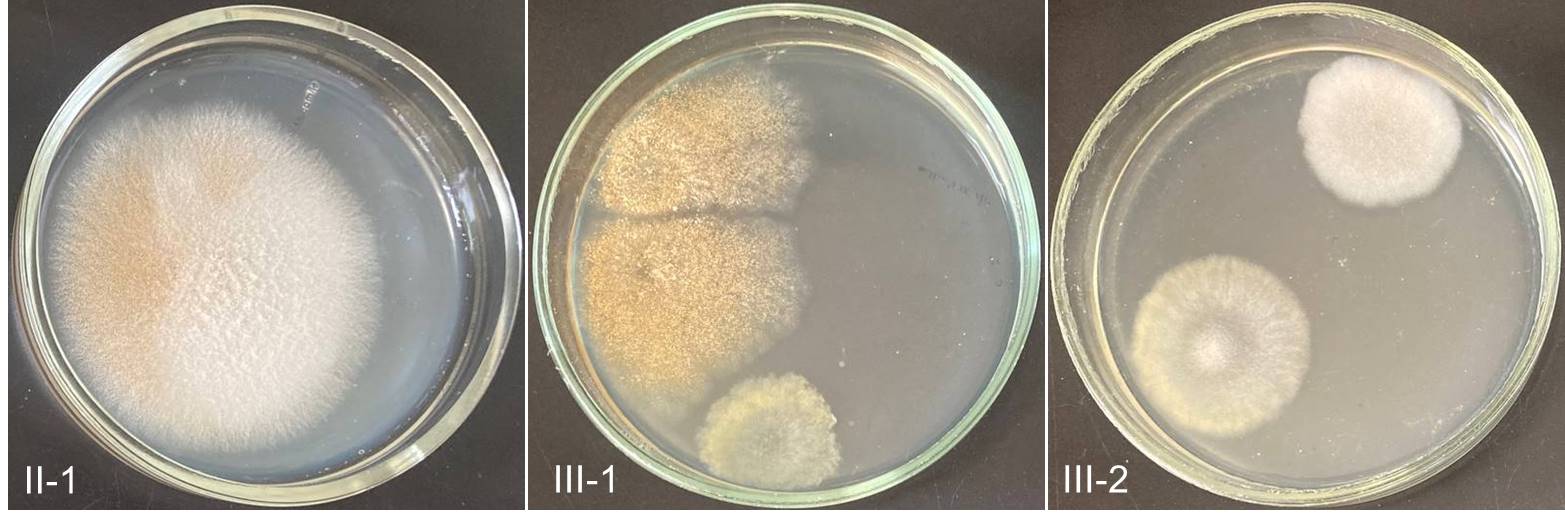-
Paper Information
- Next Paper
- Paper Submission
-
Journal Information
- About This Journal
- Editorial Board
- Current Issue
- Archive
- Author Guidelines
- Contact Us
International Journal of Genetic Engineering
p-ISSN: 2167-7239 e-ISSN: 2167-7220
2025; 13(2): 19-23
doi:10.5923/j.ijge.20251302.01
Received: Jan. 25, 2025; Accepted: Feb. 15, 2025; Published: Feb. 28, 2025

The Effect of Applied Fertilizer on the Quantity of Microorganisms in Irrigated Typical Gray Soils
Saydullayeva Zebo Temur Qizi1, Sidiqov Saidjon2, Makhkamova Dilafruz Yuldashevna3, Aliboyeva Malika Alimovna3, Atoyeva Gulkhayo Rakhmonovna3
1PhD Student in Soil Science, National University of Uzbekistan named after Mirzo Ulugbek, Tashkent, Uzbekistan
2Candidate of Agricultural Sciences, Professor, National University of Uzbekistan named after Mirzo Ulugbek, Tashkent, Uzbekistan
3Associate Professor, Department of Soil Science of the National University of Uzbekistan, Tashkent, Uzbekistan
Correspondence to: Saydullayeva Zebo Temur Qizi, PhD Student in Soil Science, National University of Uzbekistan named after Mirzo Ulugbek, Tashkent, Uzbekistan.
| Email: |  |
Copyright © 2025 The Author(s). Published by Scientific & Academic Publishing.
This work is licensed under the Creative Commons Attribution International License (CC BY).
http://creativecommons.org/licenses/by/4.0/

The article discusses the distribution of certain physiological groups of microorganisms in irrigated typical gray soils and the effects of fertilizers on them. Soil samples were taken from areas treated with control (no fertilizers), NPK, and NPK+suspension. Based on the obtained results, it was determined that among the main physiological groups of microorganisms: the quantities of ammonifying bacteria and oligonitrophilic microorganisms were found to be 1-2 orders of magnitude lower than the normal levels, Phosphorus-decomposing bacteria and azotobacter were completely absent, Actinomycetes were detected only in the 0-15 cm soil layer of the control, NPK, and NPK+suspension treatments, but their abundance was 1-2 orders of magnitude below normal levels. The highest microbial count was observed in the variants treated with NPK.
Keywords: Soil, Organic matter, Nitrogen, Phosphorus, Potassium, Liquid suspension, Fertility, Plant, Ammonifiers, Phosphorus-decomposing bacteria, Oligonitrophiles, Azotobacter, Actinomycetes, Microscopic fungi
Cite this paper: Saydullayeva Zebo Temur Qizi, Sidiqov Saidjon, Makhkamova Dilafruz Yuldashevna, Aliboyeva Malika Alimovna, Atoyeva Gulkhayo Rakhmonovna, The Effect of Applied Fertilizer on the Quantity of Microorganisms in Irrigated Typical Gray Soils, International Journal of Genetic Engineering, Vol. 13 No. 2, 2025, pp. 19-23. doi: 10.5923/j.ijge.20251302.01.
Article Outline
1. Introduction
- Soil is a living matter where plants and animals grow and develop. Microorganisms, invisible tiny organisms, play a crucial role in facilitating the life processes in soil. It is well-known that the important agronomic groups of microorganisms participating in soil formation processes significantly contribute to enhancing soil fertility. The majority of organic matter entering the soil comes from plant roots, and their decomposition leads to the formation of humus in the soil. Without microorganisms in the soil, the accumulation of organic matter on Earth would have reached such a level that life would cease to exist. According to scientists, during the photosynthesis process occurring worldwide, green plants absorb 600 billion tons of toxic carbon dioxide from the atmosphere and release 400 billion tons of pure oxygen annually. Additionally, around 450 billion tons of organic matter are synthesized globally each year. If this organic matter were only synthesized and not decomposed, life on Earth would eventually come to an endSuch organic matter produced on Earth is broken down by microorganisms into mineral substances. The significance of microorganisms in this process is boundless. Under the influence of bacteria, actinomycetes, and fungi, complex organic compounds in the soil are decomposed into simpler ones. Furthermore, organic acids formed through the activity of bacteria and fungi react with mineral compounds in the soil, participating in the synthesis of new types of compounds. Microorganisms play an exceptionally important role in soil life. The organic part of the soil consists of the decomposition products of various plants and microorganisms. Microorganisms are essential components of soil, with a single gram containing billions of them. Their total amount ranges from 3 to 10 tons per hectare of land. This is why soil is considered a living entity. As the living part of the soil, microorganisms play a crucial role in crop nutrition.The processes occurring in soil are closely related to the life activity of microorganisms. These include, primarily, the mineralization of plant and animal residues, material and energy exchange, and the replenishment of nitrogen and carbon reserves. Microorganisms also play a vital role in enriching the soil with biologically active compounds such as amino acids, auxins, vitamins, and antibiotics. The intensity of microbiological processes in the soil, as well as the quantity and quality composition of the microflora, largely depends on factors such as soil temperature, mechanical composition, water-air regime, availability of organic matter, relief structure, susceptibility to erosion, and agro-technical measures, including the application of mineral fertilizers, plowing depth, and other practices [1,6,7].The decomposition of organic matter in the soil occurs due to the biological breakdown of organic substances by microorganisms. The soil is home to a large number of various microorganisms, including bacteria, actinomycetes, fungi, algae, yeasts, lichens, and simple, low-level animals. Their numbers can vary greatly, reaching millions or even billions per gram of soil. Moreover, through the microbiological activity in the soil, its properties, conditions, and fertility are shaped. Understanding the current state of soil processes, properties, conditions, and fertility, as well as evaluating and managing its fertility, requires studying the microbiological activity of the soil. This is one of the key tasks [8,9].
2. Analysis of the References
- Proteins decompose most intensively in soils and constitute 50% of the dry mass of cells. It is believed that ammonifying groups of microorganisms play a significant role in increasing soil fertility and in soil formation processes. Ammonifiers are decomposed by aerobic and anaerobic bacteria, actinomycetes, and fungi. As a result of protein decomposition by these microorganisms, nitrogen is released in the form of ammonia. The process of ammonification is highly important for plant nutrition [11]. Ammonification is the process by which nitrogen-containing substances are decomposed by microorganisms (ammonifiers), releasing gaseous ammonia (NH₃) or ammonium ions. It is one of the most important stages of the nitrogen cycle in nature. The most active participants in ammonification are soil microorganisms and bacteria residing in the gastrointestinal tracts of various organisms. These include gram-positive, spore-forming aerobic bacteria of the Bacillus and Clostridium genera, non-spore-forming actinobacteria of the Arthrobacter, Mycobacterium, and Micrococcus genera, as well as gram-negative bacteria of the Pseudomonas and Proteus genera. Ammonifiers facilitate the mineralization of nitrogen-containing waste and the decomposition of various organisms.Ammonification occurs during the reduction of nitrates to nitrites and then to ammonia (nitrate assimilation), during the breakdown of urea by urease-producing bacteria, but primarily during the decomposition of nitrogen-containing biopolymers (including proteins and nucleic acids). In the latter case, biopolymers are first hydrolyzed into low-molecular compounds such as amino acids and nitrogenous bases, which are then deaminated to produce ammonia and nitrogen-free organic compounds. The decomposition of biopolymers is often accompanied by the release of substances with characteristic unpleasant odors, such as hydrogen sulfide, primary amines, mercaptans, and indole. Under anaerobic conditions, ammonification proceeds slowly, leading to minimal ammonia formation, with amines persisting for extended periods (in the presence of air, they are rapidly oxidized with ammonia release). The ammonification of biopolymers is sometimes referred to as putrefaction or decayed decomposition, although these terms are more commonly used to describe the anaerobic breakdown of proteins.Actinomycetes are among the most widespread microorganisms in soil. They assimilate both organic and mineral forms of nitrogen and are capable of decomposing mono-, di-, and polysaccharides, as well as animal and plant oils. Some actinomycetes can break down soil humus and chitin. They are resistant to high salt concentrations, and certain species are capable of fixing atmospheric nitrogen [10]. Alongside other microorganisms, microscopic fungi in soil play a significant role in soil fertility. Numerous species of these fungi actively participate in decomposing plant residues in the soil. The quantity of microscopic fungi depends on the degree of soil cultivation and the season of the year.There is virtually no process in the soil that occurs without the involvement of microorganisms. Microorganisms can be used as indicators to identify various processes taking place in the soil. These processes, collectively, are influenced by the conditions of soil formation, such as topography, climate, parent material, vegetation cover, soil chemical properties, and other factors [2,5,9].The number of microbial cells in the soil is influenced by external environmental factors. Observations indicate changes in the dynamics of microbial populations, the productivity of microbial biomass within soil layers, and a reduction in the relative share of various microbial groups in the overall soil biomass [3,4]. It is well known that achieving high agricultural yields often involves the use of intensive technologies, including mineral fertilizers (nitrogen, potassium, and phosphorus) as well as partially organic fertilizers (manure and partially decomposed plant residues). In recent years, the application of biologically-based fertilizers has proven highly effective. These include specialized biohumus, nitrogen-fixing and decomposing bacteria, fungi, and microorganisms with antagonistic properties that neutralize pathogenic microorganisms in the soil. Additionally, low-level algae, which serve as sources of nitrogen, minerals, and vitamins, as well as active materials like sediment sludge, have shown significant efficiency.
3. Research Methodology
- To study the quantity of the main physiological groups of microorganisms in the soil, samples were collected from depths of 0–15 cm and 15–30 cm. The microorganisms in the studied soils were cultured using specific nutrient media: ammonifying bacteria were studied on GPA (meat-peptone agar), phosphate-solubilizing bacteria on Pikovskaya medium, oligotrophs on ESHBI medium, and micromycetes and actinomycetes on Chapeka’s solid medium. A suspension was prepared from the soil samples for microbiological analysis.
4. Analysis and Results
- Ammonification is the primary stage of the nitrogen cycle in nature. As a result of plant and animal life processes, large amounts of nitrogen-containing organic matter enter the soil. These substances undergo a microbiological process called ammonification, during which ammonia is released.According to the results of microbiological analyses, the number of ammonifying bacteria in the studied soil samples ranged from 10⁶ (1 million) to 10⁷ (10 million) CFU (colony-forming units) per gram of soil. In the control variant, the number of ammonifying bacteria was 1.2×10⁷ CFU in the 0–15 cm layer and 7.5×10⁶ CFU in the 15–30 cm layer. In the NPK variant, the 0–15 cm layer contained 2.8×10⁷ CFU, while the 15–30 cm layer had 2.4×10⁷ CFU. In both the control and NPK variants for the 15–30 cm samples, Bacillus species, specifically Bacillus mycoides, were identified. In the NPK + suspension variant, the number of ammonifying bacteria was 2.7×10⁷ CFU in the 0–15 cm layer and 1.0×10⁷ CFU in the 15–30 cm layer. The results of the microbiological analyses are presented in (Figure 1).
 | Figure 1. The number of main ammonifying bacteria in the soil, expressed in colony-forming units (CFU) per gram of soil |
 | Figure 2. Oligonitrophilic microorganisms’ total number was found to be diluted up to 10,000 times |
 | Figure 3. The total number of oligonitrophilic microorganisms grown in the ESHBI medium (diluted up to 10 thousand times) in the soil samples |
 | Figure 4. The total number and appearance of micromycetes grown in Chapeka medium in soil samples |
5. Conclusions
- According to the research results, the study of the soil samples’ microflora revealed that in all the samples, the numbers of the main physiological groups of microorganisms ammonifying bacteria and oligotrophic microorganisms were 1-2 orders of magnitude lower than normal. Phosphate-solubilizing bacteria and Azotobacter were not detected at all. Actinomycetes were found only in the 0-15 cm layer samples of the control, NPK, and NPK + suspension variants, but their numbers were also 1-2 orders of magnitude lower than normal. Micromycetes were only found in the NPK and NPK + suspension variants, and their numbers were 1 order of magnitude higher than normal. It was identified that the micromycetes belonged to the genera Mucor and Fusarium. Additionally, Bacillus mycoides species were detected. The highest levels of microorganisms were found in the NPK-treated variants.
 Abstract
Abstract Reference
Reference Full-Text PDF
Full-Text PDF Full-text HTML
Full-text HTML